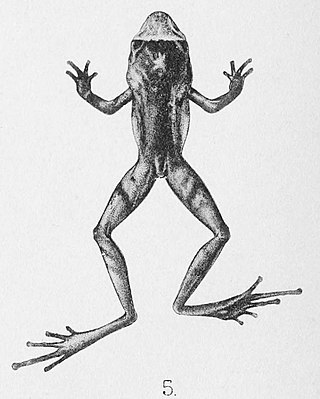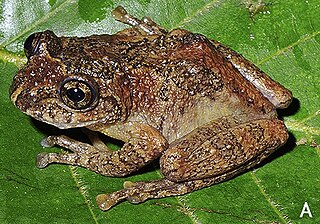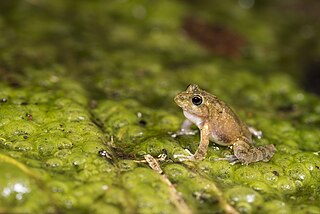
The Rhacophoridae are a family of frogs that occur in tropical sub-Saharan Africa, South India and Sri Lanka, Japan, northeastern India to eastern China and Taiwan, south through the Philippines and Greater Sundas, and Sulawesi. They are commonly known as shrub frogs, or more ambiguously as "moss frogs" or "bush frogs". Some Rhacophoridae are called "tree frogs". Among the most spectacular members of this family are numerous "flying frogs".

The Amami tip-nosed frog is a species of frog in the family Ranidae. It is endemic to the Amami Islands, a part of the Ryukyu Islands, Japan. Specifically, it is known from the islands of Amamioshima and Tokunoshima.

Raorchestes griet is a species of frog in the family Rhacophoridae. It is endemic to the Western Ghats south of the Palghat Gap in Kerala and Tamil Nadu states, India. The specific name griet honours Griet Decock, spouse of Franky Bossuyt, the scientist who described the species. The common name Griet bush frog has been coined for it.
Philautus ingeri is a species of frog in the family Rhacophoridae. It is endemic to northern Borneo and found in Sabah, Sarawak, Brunei, and adjacent northern Kalimantan (Indonesia). Common names Inger's bush frog and Inger's bubble-nest frog have been coined for it. It is named for Robert F. Inger, American zoologist from the Field Museum of Natural History.

Philautus kempii is a species of frog in the family Rhacophoridae. It is known with certainty from its type locality, Upper Rotung in Arunachal Pradesh, Northeast India, in the area also claimed by China. It is also reported from Arunachal Pradesh in general as well as from extreme eastern Tibet; these might represent another species. Very little is known about this species, and even its taxonomic validity remains uncertain.

Raorchestes parvulus is a species of frog in the family Rhacophoridae. It is found from eastern Bangladesh east through Myanmar and Thailand to Cambodia, northern Vietnam, Laos, and Peninsular Malaysia. Its distribution might well extend into northeastern India and southern China. This species was first described by George Albert Boulenger based on seven specimens collected by Leonardo Fea from Karen Hills, Burma.

Kurixalus naso, also known as uphill tree frog, long-snouted treefrog, and Annandale's high altitude frog, is a species of frog in the family Rhacophoridae. It is found in northeastern India, southern Tibet, and Bhutan. A related but unnamed species is found in Myanmar and Yunnan (China). Furthermore, it is possible that Kurixalus yangi is a junior synonym of Kurixalus naso.
Pseudophilautus maia is an extinct species of Sri Lankan shrub frogs described in 2007 from a single female museum specimen collected around 1860. It is housed at the Natural History Museum, London. It was named Top 4 New Species of 2007 by Arizona State University's International Institute for Species Exploration.
Gracixalus nonggangensis is a species of shrub frog found in southern Guangxi, China, and Cao Bang Province in northern Vietnam.

Raorchestes is a genus of frogs in the subfamily Rhacophorinae that are found in mountainous regions of South Asia, Southeast Asia, and southern China. A recent study places Raorchestes as a sister taxon of Pseudophilautus. Before the description of the genus in 2010, species now in Raorchestes had been assigned to genera Ixalus, Philautus, and Pseudophilautus.

Raorchestes kakachi is a species of frogs in the family Rhacophoridae. It is endemic to the southern Western Ghats of India. The specific name kakachi refers to the type locality from where the species was described.

Raorchestes coonoorensis, also known as the Coonore bushfrog or Coonoor bush frog, is a species of frogs endemic to the Western Ghats, India. It is reported from its type locality, Sim's Park in Coonoor, with an additional observation from Kothagiri; both locations are in the state of Tamil Nadu. Its altitudinal range is 1,780–1,850 m (5,840–6,070 ft) asl.
Polypedates subansiriensis is a species of frogs in the family Rhacophoridae. It is endemic to Northeast India and only known from its type locality, Soro village in the eponymous Lower Subansiri District, Arunachal Pradesh state. It is sometimes known as the Subansiri's tree frog or Subansiri tree frog.
Scutiger wuguanfui is a species of toad in the family Megophryidae. It is endemic to Tibet and only known from its type locality in the Medog County. The specific name wuguanfui honours Wu Guanfu, a Chinese herpetologist. Common names Wu's lazy toad, Medog lazy toad and Medog cat-eyed toad have been coined for it.

Nasutixalus is a genus of frogs in the family Rhacophoridae. The genus is found in northeastern India and adjacent southeastern Tibet as well as western Yunnan (China); the range might extend into the adjacent Nepal and Myanmar. Common name ridged-nose treefrogs has been coined for this genus.

Buergeria choui is a species of frog in the family Rhacophoridae. Prior to its description in 2020, it was confused with Buergeria japonica. It is found in northwestern Taiwan and in the southern part of the Ryukyu Archipelago, Japan, specifically on the Yaeyama Islands. Common name Yaeyama Kajika frog has been proposed for it. The specific name choui honors Wen-Hao Chou from the National Museum of Natural Science (Taiwan), the first person to pay attention to the variation within the former Buergeria japonica.
Kurixalus absconditus is a species of frog in the family Rhacophoridae. It is endemic to West Kalimantan, in the Indonesian part of Borneo, and is only known from its type locality near the village of Piasak; it is likely to occur more widely. The specific name absconditus is Latin for "disguised", "concealed", or "hidden", and refers to this species remaining "undetected" within the Kurixalus appendiculatus group. Common name Piasak-frilled swamp treefrog, also spelled Piasak frilled swamp tree frog, has been coined for it.

Zhangixalus is a genus of frogs in the subfamily Rhacophorinae, family Rhacophoridae. They are collectively known as Zhang's treefrogs. They occur in the Eastern Himalayas, southern China, Taiwan, Japan, and southeast Asia.
Gracixalus seesom, also known as the orange bush frog or orange bushfrog, is a species of frog in the family Rhacophoridae. It is endemic to northwestern Thailand and is known from the Kanchanaburi and Chiang Mai Provinces.
Raorchestes huanglianshan, the Huanglianshan bush frog or Huanglianshan shrub frog, is a species of frog in the family Rhacophoridae. It is endemic to China and Thailand. Scientists have observed it on Mt. Huanglian, between 1600 and 1900 meters above sea level.













